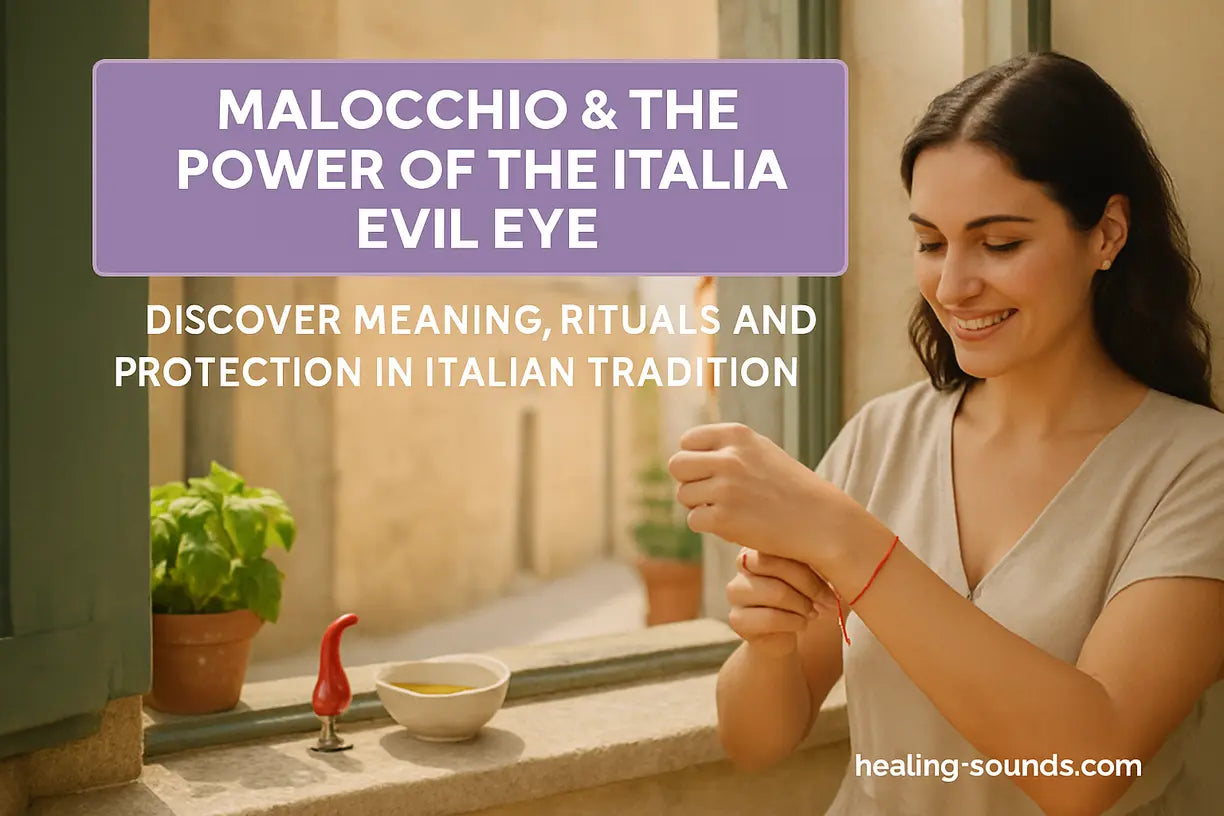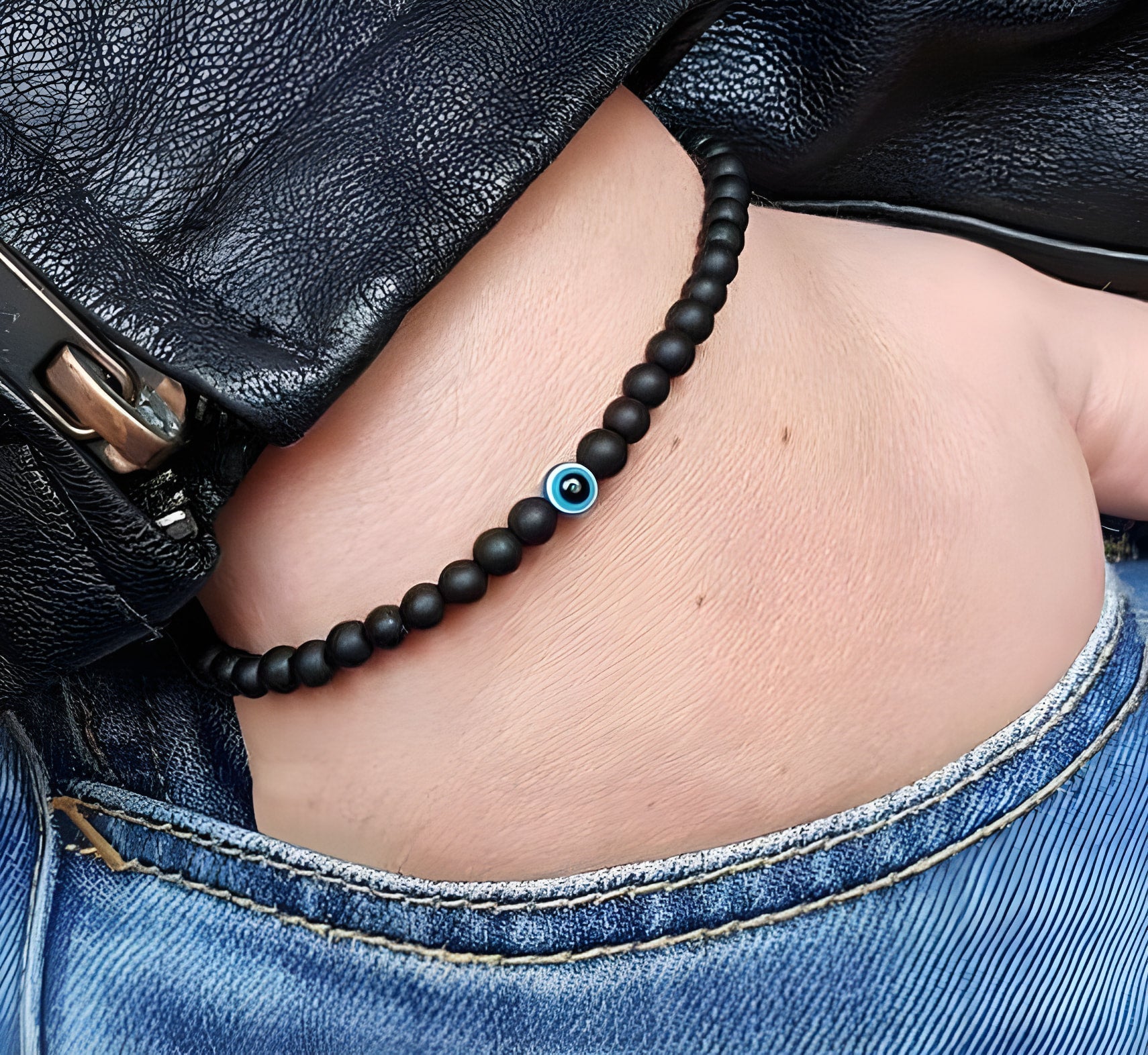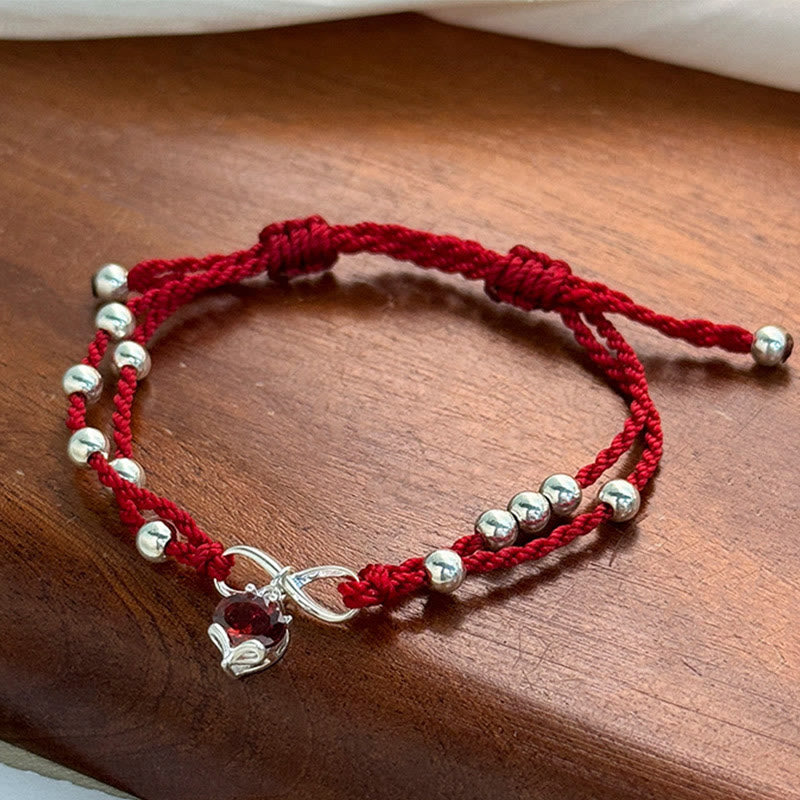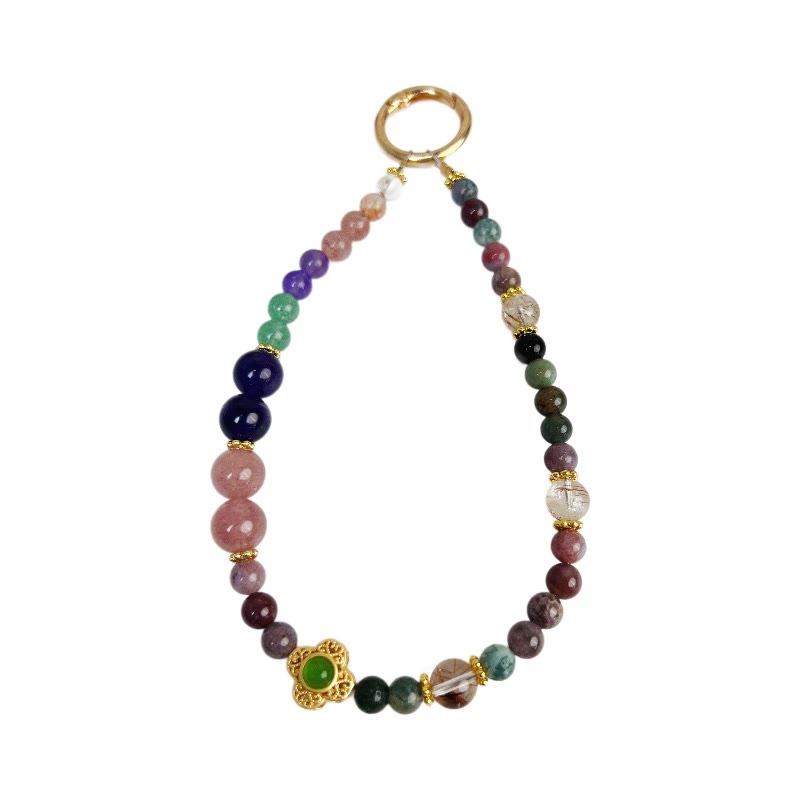L'attrait des traditions anciennes et la quête de protection spirituelle trouvent un écho profond chez beaucoup d'entre nous. Si vous êtes attiré par le symbolisme culturel, l'héritage italien ou le bien-être holistique, vous avez probablement entendu parler du « Malocchio » ( mauvais œil italien ). Cette croyance ancestrale, ancrée dans l'histoire et le folklore, continue de captiver et d'influencer les vies. Mais qu'est-ce que le Malocchio exactement et comment s'est-il intégré à la culture italienne ? Cet article explore le cœur de la tradition du Malocchio, sa signification, ses symboles emblématiques, ses rituels de protection traditionnels et sa pertinence toujours d'actualité. Vous découvrirez l'univers fascinant du « Malocchio » italien et comprendrez comment ces pratiques ancestrales peuvent encore offrir un sentiment de sécurité et un lien avec un riche héritage culturel.
Qu'est-ce que le Malocchio ? Le mauvais œil italien expliqué
Le terme « Malocchio » (souvent orthographié « mal'occhio ») signifie littéralement « mauvais œil » en italien. Il s'agit d'une croyance profondément ancrée dans la culture italienne, et même dans de nombreuses cultures méditerranéennes et internationales, selon laquelle une personne peut, involontairement ou par malveillance, causer du tort, de la maladie ou du malheur à autrui simplement en la regardant avec envie ou jalousie. Il ne s'agit pas nécessairement de malédictions ou de sorcellerie au sens dramatique du terme, mais plutôt d'une force plus subtile et omniprésente. Dans la tradition italienne, le mauvais œil est souvent perçu comme la conséquence d'éloges ou d'admirations excessifs, même sans mauvaise intention, car une telle attention peut attirer des énergies négatives.
Les origines de cette croyance sont anciennes, antérieures à l'époque romaine, et ont des parallèles en Grèce et dans d'autres civilisations antiques. Depuis des générations, les Italiens, notamment dans les régions du sud comme la Sicile et Naples, transmettent des histoires et des pratiques liées au Malocchio. On pense qu'un mal de tête soudain, une fatigue inexpliquée ou une série de coups du sort peuvent être attribués au fait que quelqu'un vous a donné le Malocchio. Comprendre la signification du mauvais œil italien est essentiel pour saisir sa signification culturelle et les diverses mesures de protection développées au fil des siècles.
Reconnaître les signes : symptômes de Malocchio
Bien que variant selon la région et la tradition familiale, certains symptômes fréquemment cités, censés indiquer qu'une personne a été atteinte du Malocchio, comprennent :
- Maux de tête soudains et inexpliqués ou sensation de lourdeur dans la tête.
- Fatigue, somnolence ou faiblesse inhabituelles.
- Une série d'accidents mineurs ou de malchance.
- Nausées ou maux d’estomac inexpliqués.
- Difficulté à se concentrer ou sensation d’être « vidé ».
- Chez les bébés, pleurs excessifs ou agitation.
Il est important de se rappeler qu’il s’agit de croyances traditionnelles, mais pour beaucoup, elles constituent une façon de donner un sens et de réagir aux événements moins agréables de la vie.
Symboles clés et charmes pour la protection de Malocchio
Pour contrer la menace perçue du mauvais œil, une riche collection de symboles protecteurs et d'amulettes a été créée en Italie. Ces objets ne sont pas seulement décoratifs ; ils sont imprégnés de signification culturelle et sont activement utilisés pour éloigner les énergies négatives.
Le Cornicello : le cor italien emblématique
Le symbole italien du mauvais œil le plus célèbre est sans doute le cornicello , ou « petite corne ». Cette amulette, généralement en forme de corne torsadée et souvent fabriquée en corail rouge, en or ou en argent, est censée détourner le Malocchio. Sa forme phallique la rattache également à d'anciens symboles de fertilité et de bonne fortune. Le cornicello est couramment porté en pendentif sur un collier ou un bracelet, ou accroché dans les maisons et les voitures pour se protéger. La croyance veut que sa forme pointue « transperce » ou détourne le regard envieux.
La Mano Cornuta : le geste de la main cornue
La Mano Cornuta , ou « main cornue », est un autre puissant symbole de protection. Ce geste, réalisé en tendant l'index et l'auriculaire tout en repliant le majeur et l'annulaire sous le pouce, imite les cornes. Elle est utilisée pour conjurer le mauvais œil, souvent dirigé vers le bas ou vers la source de la négativité perçue. C'est une forme de protection rapide et accessible, que l'on peut utiliser discrètement lorsqu'on se sent vulnérable à un regard envieux ou malveillant. Ce symbole italien du mauvais œil est courant en Italie.

Autres amulettes et pratiques protectrices
Au-delà du cornicello et de la mano cornuta, d'autres objets et pratiques contribuent à repousser le Malocchio. Des rubans ou des ficelles rouges sont souvent attachés aux berceaux des bébés ou portés pour les protéger. L'ail, le sel et même des prières ou incantations spécifiques jouent un rôle dans différentes traditions familiales. De nombreux Italiens portent également des médailles religieuses aux côtés de ces amulettes populaires, alliant foi et tradition. L'essentiel réside dans l'intention et la croyance investies dans ces symboles de protection.
Porter des bijoux protecteurs arborant ces symboles traditionnels est une façon populaire de les préserver. Des articles comme des bracelets ornés de motifs contre le mauvais œil ou des breloques cornicello allient héritage culturel et style personnel, offrant un lien tangible avec ces croyances ancestrales.
Bracelet en onyx noir avec symbole du mauvais œil
$29.99 $39.99
Dynamisez votre journée avec ce bracelet mauvais œil en onyx noir, alliant tradition et style italiens pour une protection et un ancrage quotidiens.
Explorer le produitRituels traditionnels : comment éliminer le Malocchio
Si une personne pense être atteinte du Malocchio, des rituels spécifiques sont traditionnellement pratiqués pour le diagnostiquer et l'éliminer. Ces pratiques sont souvent transmises au sein des familles, généralement par des femmes âgées, considérées comme les gardiennes de ce savoir populaire.
Le rituel de l'huile d'olive et de l'eau
Le rituel le plus courant pour détecter et tenter de guérir le Malocchio consiste à utiliser un bol d'eau et quelques gouttes d'huile d'olive. La personne qui accomplit le rituel (souvent une nonna ou un ancien expérimenté) fait le signe de croix et récite des prières spécifiques, parfois une prière de Malocchio italienne en anglais ou, plus traditionnellement, dans un dialecte local. Des gouttes d'huile d'olive sont ensuite versées dans l'eau.
La façon dont l'huile se comporte dans l'eau est interprétée pour diagnostiquer la présence et parfois la gravité du Malocchio :
- Si les gouttes d'huile se dispersent, forment de petites gouttelettes ou créent une forme « d'œil » (seule ou avec un halo), cela est souvent considéré comme un signe que Malocchio est présent.
- Si les gouttes d'huile restent entières et flottent, cela peut indiquer l'absence de Malocchio ou que le rituel vise à le dissiper.
Le rituel peut être répété, souvent trois fois, avec des prières continues jusqu'à ce que l'huile se comporte « normalement », signifiant que le Malocchio a été levé. Cette pratique illustre magnifiquement le mélange de foi, d'éléments naturels et d'intention dans la médecine traditionnelle italienne. Pour plus d'informations sur le symbolisme de l'huile d'olive en médecine, vous pouvez consulter des ressources comme Olive Oil Times , qui aborde souvent les usages culturels de l'huile d'olive.

Prières et incantations
Outre le rituel de l'huile et de l'eau, des prières spécifiques (preghiere) et des incantations (scongiuri) sont essentielles pour dissiper le Malocchio. Ces prières sont souvent spécifiques à chaque famille ou région et sont récitées avec une intention précise. Si certaines sont issues de prières catholiques, beaucoup sont des versets populaires transmis oralement. Le pouvoir de ces mots, combiné aux gestes rituels, est censé briser l'influence négative.
Conseils rapides pour la protection personnelle :
- Soyez attentif à la personne avec qui vous partagez immédiatement une bonne nouvelle ; parfois, une envie inconsciente peut surgir.
- Portez un petit charme protecteur, comme un cornicello ou un morceau de corail rouge.
- Apprenez le geste Mano Cornuta pour une protection discrète.
- Faites confiance à votre intuition : si une situation ou une personne vous semble épuisante, créez une certaine distance.
Conjurer le mauvais œil au quotidien
Au-delà des rituels spécifiques d'élimination, la culture italienne regorge de pratiques pour se protéger proactivement du Malocchio. Il s'agit souvent d'actions et d'attitudes simples et quotidiennes visant à préserver une protection contre la négativité.
Faire discrètement la Mano Cornuta (geste de la main cornue) lorsqu'on ressent une pointe de jalousie ou qu'on reçoit un compliment trop élogieux est une pratique courante. Toucher le fer (fare le corna toccando ferro) est un autre geste censé ancrer les énergies négatives. Certains pensent également que dire « Grazie, altrettanto » (« Merci, pareil pour toi ») lorsqu'on reçoit un compliment peut détourner toute négativité involontaire, ou plutôt, partager la bonne fortune.

Aujourd'hui, ces traditions perdurent, souvent mêlées à la spiritualité moderne. Porter un pendentif ou un bracelet italien contre le mauvais œil n'est pas seulement un accessoire de mode, mais un choix conscient de porter un élément du patrimoine culturel et un symbole de protection. La croyance au pouvoir de l'intention, à l'énergie positive et au respect de ces protections ancestrales reste forte pour beaucoup, offrant un sentiment de réconfort et de connexion dans un monde en constante évolution.
Découvrez des objets symboliques pour la protection et le bien-être
$35.90
$51.90
Inspirez-vous d'une protection ancienne et interculturelle avec cet élégant bracelet en fil rouge, inspiré des traditions de protection de Malocchio. En savoir plus ➔
$24.90
$35.90
Décorez votre espace avec ce charme en cristal, pour une énergie protectrice inspirée du mauvais œil italien et des croyances du malocchio. En savoir plus ➔
L'héritage durable de Malocchio dans la culture italienne
Le Malocchio est plus qu'une simple superstition ; c'est un élément vivant du patrimoine culturel italien, reflet de croyances profondes sur les liens humains, l'envie et les forces invisibles qui peuvent influencer notre bien-être. Des rues animées de Naples aux paisibles villages de Sicile, en passant par la diaspora italienne à travers le monde, les traditions entourant le mauvais œil italien perdurent. Ces croyances et pratiques offrent un aperçu fascinant de la manière dont une culture affronte le malheur et cherche à donner aux individus des outils de protection et de guérison. Pour en savoir plus sur les traditions folkloriques mondiales, l' American Folklore Society propose de nombreuses ressources et recherches.
Qu'elle soit perçue comme une menace littérale ou une représentation symbolique des défis de la vie, la tradition Malocchio encourage la pleine conscience, le respect des liens protecteurs et le lien avec la sagesse ancestrale. Elle témoigne du besoin humain persistant de sens, de sécurité et de réconfort que procurent les pratiques culturelles partagées.
Conclusion
Le mauvais œil italien , ou Malocchio, est un phénomène culturel profond qui offre bien plus qu'un folklore fascinant. Il témoigne d'une compréhension profonde des émotions humaines telles que l'envie et le désir de protection et de bien-être. En explorant ses symboles comme le cornicello et la mano cornuta , en comprenant ses rituels d'éloignement et en appréciant ses mesures de protection quotidiennes, nous découvrons un riche patrimoine italien qui continue de prospérer. Ces traditions offrent non seulement un bouclier contre la négativité perçue, mais aussi une belle façon de se connecter à la sagesse ancestrale et de trouver du réconfort dans une identité culturelle commune. Au fil de votre propre cheminement, ces protections ancestrales pourraient vous offrir une touche de protection et une plus grande appréciation du pouvoir durable de la croyance.
Chez Healing Sounds, nous honorons ces traditions en proposant des articles qui résonnent avec ces énergies protectrices, vous permettant d'emporter avec vous un morceau de ce riche héritage.
Questions fréquentes sur le mauvais œil italien (Malocchio)
Le mauvais œil italien, appelé « Malocchio » (ou « mal'occhio »), est une croyance traditionnelle selon laquelle quelqu'un peut causer du tort, de la maladie ou du malheur à autrui, intentionnellement ou non, par un regard envieux ou excessivement admiratif. C'est une croyance populaire très répandue dans la culture italienne, notamment dans le sud de l'Italie, et ses origines sont anciennes.
Traditionnellement, le Malocchio est éliminé par des rituels spécifiques, souvent exécutés par un membre âgé de la famille. Le plus courant consiste à verser de l'huile d'olive dans un bol d'eau tout en récitant des prières. Le comportement de l'huile indique la présence du Malocchio et l'efficacité du rituel pour le dissiper. Des prières et des incantations spécifiques sont également essentielles au processus d'élimination.
Le principal symbole italien contre le mauvais œil est la « Mano Cornuta » (main cornue). Ce geste consiste à tendre l'index et l'auriculaire, tandis que le majeur et l'annulaire sont repliés sous le pouce. Il est utilisé pour conjurer le mauvais œil, souvent pointé vers le bas ou vers une source perçue comme négative.
Se protéger du Malocchio implique diverses méthodes traditionnelles : porter des amulettes comme le Cornicello (corne italienne) ou des cordons/rubans rouges ; faire des gestes protecteurs comme la Mano Cornuta ; afficher des symboles protecteurs à la maison ; et réciter des prières spécifiques. Être attentif à l'envie et pratiquer l'humilité sont également considérés comme des mesures préventives.
Dans la culture italienne, « Malocchio » (qui signifie « mauvais œil » ou « mauvais œil ») désigne le malheur, la maladie ou la malchance générale, supposés être causés par le regard envieux ou admiratif d'autrui. C'est un aspect important de la tradition populaire, influençant les interactions sociales, les pratiques protectrices et les rituels de guérison visant à contrer cette influence négative.







